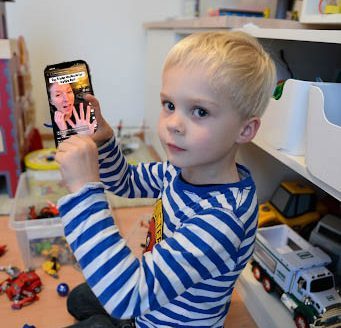Rolls right off the tongue
photo by Kathlynn Nguyen
Sophomore Kathlynn Nguyen writes down notes from her Vietnamese language book. She attends a virtual language school every Saturday.
Try forming a sentence without saying “the.” It might be easy once, but a whole conversation without “the” is a little more difficult. Yet, in Mandarin, this is normal, and dialogue flows naturally for native speakers, like senior Alex Tao’s parents. In fact, Tao once held an hour-long conversation with his dad in English without ever using the word “the,” inspiring him to pursue new languages himself. Tao currently studies Mandarin, Spanish and French using Duolingo for around 30 minutes a day.
“I [hope] to catch a glimpse of how millions of immigrants like my parents experience the world,” Tao said.
Language learning is a widely shared experience, with people all around the world turning to Rosetta Stone and Memrise to strike up a conversation with their local Portuguese cashier or on their newest work venture in India.
According to the Washington Post, at least half of the world’s population is bilingual. Despite being common, becoming proficient in a language can be intimate and meaningful. For senior Lainey Butler and her boyfriend, senior Lukas Schoenfeld, language is about the connection to family. They began learning Polish last summer, in an attempt to fit in with Schoenfeld’s Polish-speaking relatives at family gatherings.
“We wanted to be a part of the conversation, especially when we heard our names in the discussion,” Butler said.
Getting comfortable with a different language takes time and effort, especially with the thousands of different dialects, writing characters and alphabets. According to BBC, there are four tiers of difficulty in foreign languages for native English speakers. The lower the rank, the easier it is to learn. For example, Spanish and French are part of group one, while Japanese and Korean are group four languages.
To reach basic fluency, it takes around 480 to 720 hours of dedication. Over the summer, senior Jacob Carlson started learning Arabic to broaden his worldview. Arabic is a group four language and it takes around 2,200 hours to gain proficiency. While English is written from left to right, Arabic is written from right to left, something Carlson found a struggle.
“It was difficult to keep up with,” Carlson said. “I struggled greatly with learning a whole new system of reading and writing, and ended up stopping once school started.”
Although some choose to practice on their own, others attend formal schools to study their language. Sophomore Kathlynn Nguyen has been learning Vietnamese at a virtual language school on the weekends for the past three years to better communicate with her family. Even though Vietnamese is her mother tongue, she still faces challenges while learning.
“Talking in Vietnamese is so different from just reading and writing. Since Vietnamese cooperates different intonations and grammar placement, it took a little bit of time to get used to,” Nguyen said.
Whether someone is taking a class or teaching themselves, language learning apps, YouTube videos and textbooks are the keys to success. Changing a phone’s settings to the target language and constantly interacting with it by reading books, watching movies and TV shows can help increase fluency, all while providing a source of entertainment. Nguyen likes to do this by reciting what she learned for at least 10 minutes a day and listening to stories in Vietnamese.
“Staying consistent really helps. It is difficult to stay persistent and motivated, but it pays off,” Nguyen said.
Even though there are obstacles, many find learning another language enjoyable because it boosts confidence and appreciation for other cultures. It can be nervewracking to tackle it alone, but starting with someone else can ease this tension, something Butler does herself.
“I love studying with Lukas. We have fun with it and make each other laugh,” Butler said.
Experts say the best way to enhance learning is to talk with someone who is already fluent in that foreign language. This can mean neighbors, family or friends; even apps like HelloTalk can help a learner chat with native speakers from around the world. People can forge relationships with others, regardless of a language barrier. Tao enjoys connecting with others by using what he has learned, and even helped a woman find bikes for her children at his local community center by talking in Spanish.
“I will never forget how her face lit up when I spoke to her in her native language,” Tao said.
Your donation will support the student journalists of Hagerty High School. We are an ad-free publication, and your contribution helps us publish six issues of the BluePrint and cover our annual website hosting costs. Thank you so much!








